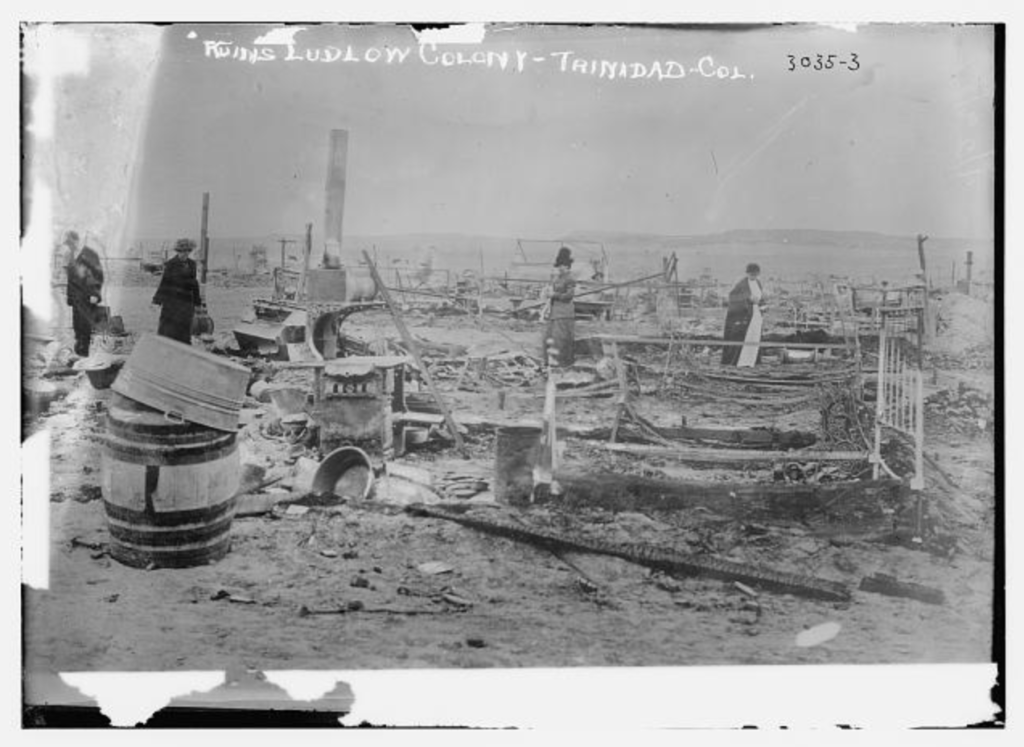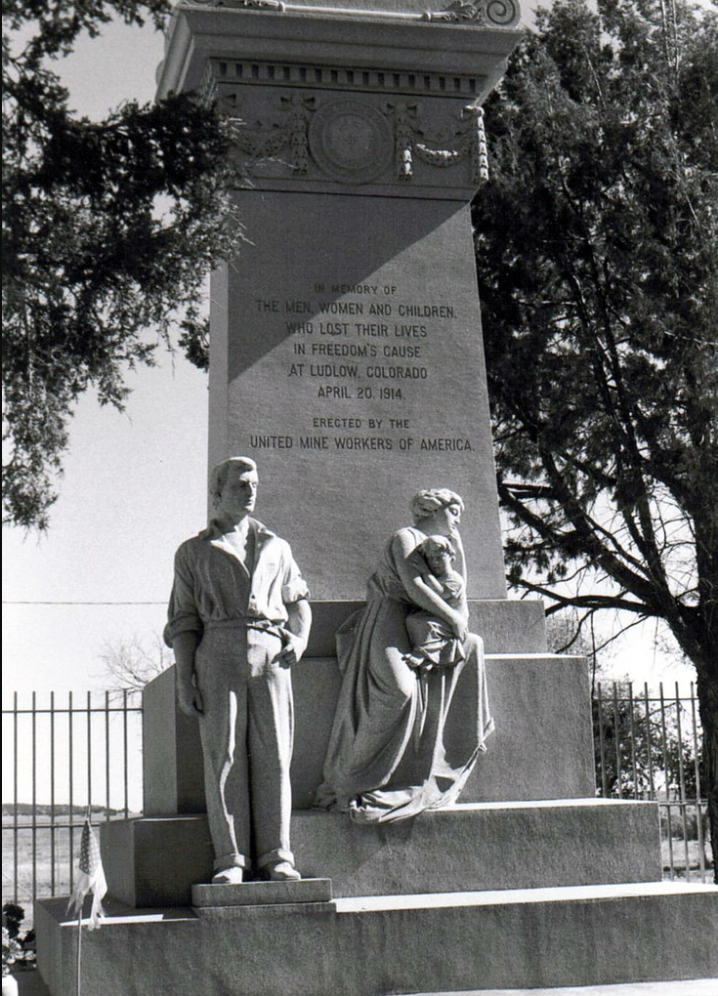The Ludlow Massacre
A long-lasting coal miner strike on the Colorado Fuel and Iron Company, owned and managed by John D. Rockefeller Jr, came to a violent end on April 20, 1914, in the Ludlow tent colony. Three bombs exploded in the colony within minutes of each other, causing panic and chaos. These explosions were very soon followed by gunshots. Colorado state militia members and Baldwin-Felts Detective Agency company men hired by Rockefeller set fire to the encampment and began firing indiscriminately on the families who lived there. A Colorado miner, who was only a young boy at the time of the attack and living in the next town over, later described his view of the events, “We could see the glare, the fire, they went up in no time. Them flames sweep those tents like confetti” (Bisulco, 1977). Armored cars rigged with machine guns, bleakly yet aptly described as “death specials” surrounded the area. Perhaps one of the grimmest locations in what was left of the town is what is known as the “black hole” where the bodies of 11 children, none older than seven years old, and 2 women were discovered. In total, this massacre resulted in the confirmed deaths of 21 men, women, and children.

Following this initial attack, surviving miners stood against the mercenaries, militiamen, and strikebreakers in what would come to be known as the Ten Days War. Violence spread to tent colonies across the state. Fires were set and bodies were burned. Nurses and doctors from the Red Cross were prevented by the militia from entering the colony and administering aid. In some cases, they were even fired at themselves. Women and children who were caught in their attempts at escape were held prisoner. Once the Red Cross was finally allowed access into the Ludlow colony two days later, they were not allowed to conduct official searches. Therefore, it is unknown how many of the 1,200 people who lived in Ludlow died during these events. Pleas to the state governor, Governor Ammons, including a protest on the state capitol by over 1,000 women, eventually prompted a request to President Wilson to send in federal troops. These troops intervened under President Wilson’s orders on April 29. The presence of federal forces saw an eventual end to the extreme violence. Still, once the fighting was put to an end, strikes continued in several Colorado tent colonies for another 14 months. Ultimately, these strikes led to a loss for the United Mine Workers of America. However, a series of meetings primarily led by Mother Jones, a prominent figure in the labor movement, were held across the country in order to bring the situation in Colorado to the nation’s attention. Actions like this, as well as published statements from the UMWA, prevented the narrative that strikers instigated the violence from taking hold and paved the way for eventual change.
Memorializing Tragedy

Colorado Massacre on Coal Miners” by Beverly & Pack is
licensed under CC BY 2.0.
Citizens and survivors very quickly began to look for ways to remember these events and honor the dead. Memorial services would be held on the anniversary of the massacre and in 1916, the United Mine Workers of America purchased the site of the massacre with plans to erect a monument. In 1917, the UMWA, published a letter in the Denver Labor Bulletin requesting donations from local unions and the general public for a monument to the Ludlow Massacre. $12,000, the equivalent of about $250,000 dollars were raised and the monument was unveiled in a formal ceremony on May 30, 1918. The final structure is six feet tall, built from gray granite, and features the figures of a miner and a woman holding a child. The engraving on the front of the monument reads:
In Memory of
the men, women and children,
who lost their lives
in freedom’s cause
at Ludlow, Colorado
April 20, 1914
Erected by the
United Mine Workers of America
The back of the monument lists the names and ages of the individuals who died on this day. This memorial frames these victims as martyrs for the cause of the labor movement. In the very letter calling for donations, executive members of the UMWA appeal,
Let it not be said that they died in vain and that their martyrdom has been forgotten by the hosts of labor.
It is worth noting that not all positions on the memorial were favorable. Around this time, the president of the United Mine Workers of America, Frank Hayes, was coming under fire for not speaking out against, and possible taking active part in election fraud within the American labor movement. During the fourth-anniversary memorial services, union leader John R. Lawson made the following statement in his address:
There may be a monument built to mark the spot where those brave men died, where the women and children perished in the black hole at Ludlow, but it will also mark the time when the international officers of that once great union have stooped to the lowest depth of political degradation. It may be called a monument, but to the rank and file of union miners of Colorado and to those who gave up their lives that truth, right and justice might live, it will only be a stone.
In 2003, the Ludlow Massacre Memorial was severely damaged. The heads of the male and female figures, as well as an arm were broken off and stolen. This resulted in the Labor and Working-Class History Association beginning preparations to name the memorial an official national landmark. Six years later, in 2009, the memorial was officially recognized as a National Historic Landmark. According to labor movement historian, Sean Antaya, “it remains a pilgrimage of sorts for union members and labour (sic) historians throughout North America.” There is still a continued effort put towards the maintenance of the massacre site, chiefly by the UMWA. Soon after the massacre, the “black hole”, where the remains of several women and children were recovered, was lined with cement as an act of preservation. More recently, an archaeological project in 2021 was initiated with the goal of reinforcing and further preserving the “black hole”. During this process 744 artifacts were uncovered and remain preserved. The aftermath of these events unified a community in grief and played a larger role in the labor movement and the push for reform. The Ludlow Massacre was a tragic and violent event, but now, over one hundred years later, the victims continue to be remembered and honored.
References
Antaya, S. (2023). Left Americana and the Ludlow Monument. Labour / Travail, 92, 309–314. https://doi.org/10.52975/llt.2023v92.0012
Bisulco, A. (1977). A miner in Aguilar recalls the Ludlow Massacre (B. Beshoar, Interviewer) [Interview]. https://cudl.colorado.edu/luna/servlet/detail/UCBOULDERCB1~76~76~1102519~285616
Denver labor bulletin. (Denver, Colo.), 01 May 1915. Chronicling America: Historic American Newspapers. Lib. of Congress.
Denver labor bulletin. (Denver, Colo.), 23 June 1917. Chronicling America: Historic American Newspapers. Lib. of Congress.
Denver labor bulletin. [volume] (Denver, Colo.), 27 April 1918. Chronicling America: Historic American Newspapers. Lib. of Congress.
Denver labor bulletin. [volume] (Denver, Colo.), 18 May 1918. Chronicling America: Historic American Newspapers. Lib. of Congress.
Fink, W. H. (Walter Hedges). (1914). The Ludlow massacre. [Denver: Williamson-Haffner, printers.
Jones, M. (1925). The autobiography of Mother Jones. Charles H. Kerr & Company.
Larkin, K., & Bauer, S. (2024). Memorialization and Social Memory at the Ludlow Massacre Site. International Journal of Historical Archaeology, 28(3), 816–855. https://doi.org/10.1007/s10761-024-00733-x
United labor bulletin. (Denver, Colo.), 02 May 1914. Chronicling America: Historic American Newspapers. Lib. of Congress.
